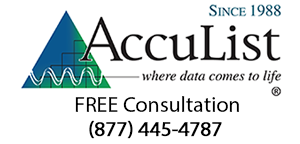Weaponize B2B Data for 2019 With These Tactics
Targeted, clean data is a key deliverable of AccuList USA’s data services and list brokerage efforts for business-to-business marketing clients. And as those clients prepare their 2019 plans, we urge them to take basic steps to ready their data-driven marketing for maximum performance. A Martech Today post by Scott Vaughn sets the stage by recommending five essential data-oriented strategies for B2B.
Precisely Defined Audience Targets Using Clean Data
Good response and conversion depend on identifying and engaging the right audiences, meaning the right companies and the right decision-makers within those companies, Vaughn reminds. To target that right audience requires processes for capturing critical data about prospects, customers and their purchase journey with precision, he asserts, and recommends a strategy of starting with a smaller universe of accounts and roles to more precisely define best targets–and then testing and using advanced strategies, such as predictive marketing and intent-data modeling, to expand to more accounts and buyers. But that kind of data targeting only works if marketers are looking at quality data, so data hygiene is another necessity. When a recent DemandGen survey finds that more than 35% of the data in existing databases is unmarketable on average, avoiding wasted dollars means instituting a “get clean, stay clean” data-hygiene effort for 2019, Vaughn urges. The hygiene regimen should include regularly auditing of data-capture processes and sources, using filters before data can enter the database, and maintaining a cleansing process to eliminate records that are invalid, non-standardized, duplicate or non-compliant.
Permission-Based Trust and Speedy Follow-up
Because today’s buyers are leery of companies and brands that don’t treat their information with care and because stringent data-privacy laws are being deployed around the globe, B2B marketers must have a proactive permission-based marketing plan for their data, warns Vaughn That includes asking for opt-in everywhere and having very visible, clear explanations of how behavioral data, such as website cookies, is used. Meanwhile, prospects and customers have not only come to expect data privacy, they have become used to the rapid, real-time response of the digital market. Yet for many B2B campaigns, it takes two or three days to follow up on a lead or inquiry, or even seven or eight days just to get leads loaded into marketing automation or CRM software! Vaughn proposes a concerted effort to speed data handling by identifying areas where data can be routed faster and reaction time reduced and then initiating sales and marketing training on speedier handling at each stage of the customer journey. That’s why many executive teams now prioritize a measure of “pipeline velocity,” meaning the time from when an opportunity is created to when the deal is closed, to improve revenues.
Agreeing on Measurements That Matter
Accurate, targeted, speedy data processes don’t automatically result in ROI improvement, however–not if data analysis ends up focused on the wrong metrics. Vaughn reports that high-performing marketing teams use insights with these key ingredients: agreed-upon key performance indicators (KPIs); tools that can measure performance; and easy-to-use dashboards that can help all stakeholders (marketing, sales, execs, etc.) make smarter decisions. For his complete article, see https://martechtoday.com/5-essential-strategies-b2b-marketers-must-master-in-2019-228066


